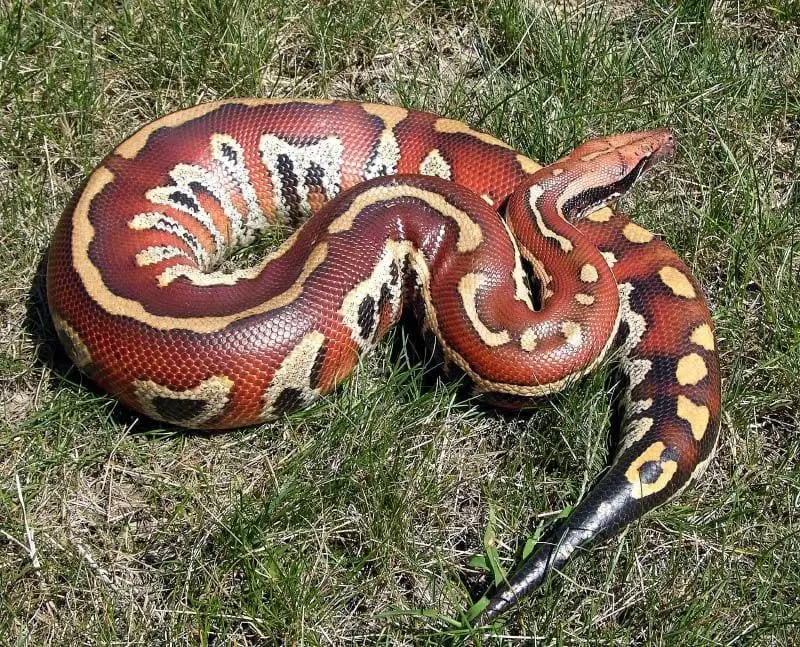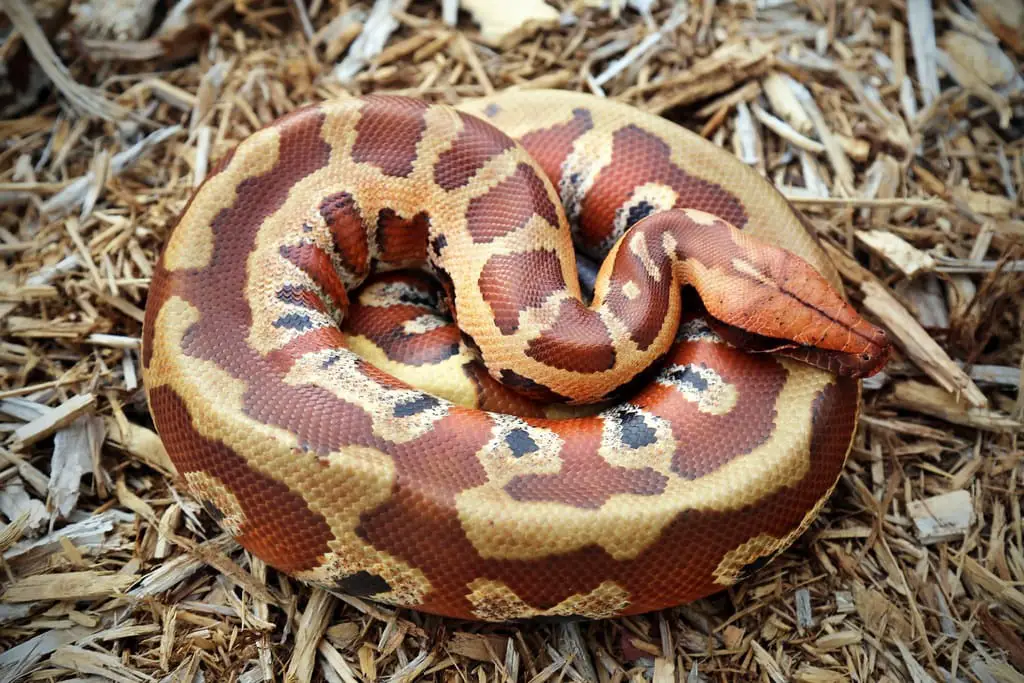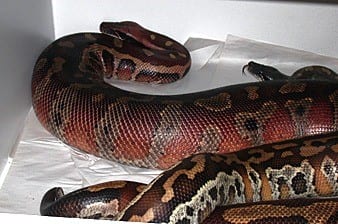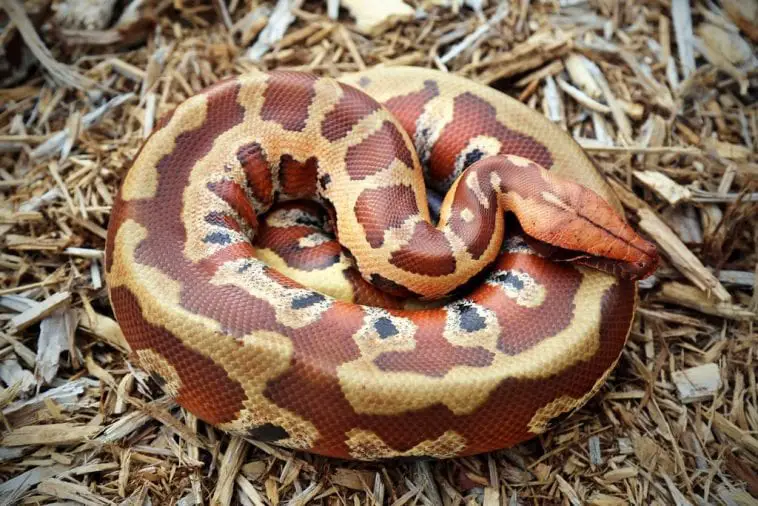Scientific Facts
| Common Name | Blood Python, Red Blood Python, Sumatran Blood Python, Red Short-Tailed Pytho, Brongersma’s Short-Tailed Python, Malaysian Blood Python |
| Scientific Name | Python Brongersmai |
| Life Span | 20 to 25 years |
| Length | 3 to 5 feet |
| Clutch Size | 12 to 16 eggs |
| Habitat | Wet, Upland or Forested Hills |
| Country of Origin | Malay Peninsula, Thailand, Sumatra |
Physical Description

The blood python is a heavy-bodied snake characterized by a muscular, thick body with variable coloration and markings. They have broad, flat, and long heads, which is wider, and very distinct than their neck. These snakes are unique in a way that they come with a huge girth in relation to their length. This is because of their robust structure, making them look overweight. Adult specimens may weigh more than 20 pounds.
The color of their body ranges from brown, tan, yellow, or cherry red, even oxblood, and covered with tan, lighter gold, orange, or gold, and black blotches and stripes. They usually have a belly that is typically white, often with some small blackish marks.
The head of blood pythons is usually gray in color, even though certain specimens may show some black to reddish head. This variety of snake is also characterized by their changing head colors. This means that a snake that has a black-colored head in the morning may turn out to have a very pale and faded head color in the evening.
Male adult blood pythons usually range from 36 to 60 inches (91 to 152 cm) in length. On the other hand, females are generally smaller, ranging between 48 to 72 inches (120 to 180 cm). Some specimens were even recorded to have reached a length that is more than the usual.
History
The blood python is a snake breed that has become popular in reptile care and zoos since the early part of the 1900s. Wild-caught snakes usually come from Sumatra or Malaysia. They are also found in areas in Thailand and are usually found in wet, upland, or forested hills as habitat within these regions.
Since those years, the blood pythons which are kept in captivity have gone through a lot of changes because of changing markets, as well as the effects of the number of pythons raised in captivity. There are a number of reasons why these snakes have become popular. For one, they are quite easy to maintain, in comparison with other snakes. They are also pretty huge without being overwhelming, and they love feeding. These characteristics of the blood pythons make them an interesting reptile to care for, even though they can be somewhat temperamental at times.
Reputation
We often hear reports from snake enthusiasts referring to the attitude of blood pythons as temperamental. They were often reported as untrusting and unpredictable even after several years in captivity. During the past decade, most blood pythons that were imported came from Sumatra. They tend to be different, being easygoing.
There are some long-term Sumatran captive blood pythons that are trusting and calm, similar to those that are captive-bred and born varieties. In fact, they are even regarded as some of the friendliest snakes there is. Throughout the years, Sumatran and Borneo blood pythons have been associated together, thus removing the negative reputation and attitude linked to them. They are now being viewed as laid-back, beautiful, and docile snakes.
Size
Even though blood pythons are not considered as the largest among the snakes’ category, their size is also something that should never be underestimated. They are very heavy, with quite a large girth. One look at a blood python will make you notice that they have a short tail, with a head that is both long and broad.
Once they have reached full maturity, the male snakes typically measure between 40 and 56 inches in length. Female snakes, on the other hand, measure between 50 and 66 inches in length. Females that are really old are known to reach up to 72 inches and more, weighing up to 40 to 45 kilograms if they are being overfed.
Lifespan
There is no clear information as to the actual length of years in which blood pythons live in the wild. However, some captive-bred or captive-kept snakes have lived for over 20 years. In most of these cases, the length of time in which blood pythons live is often associated with their size. In order to keep them in their best condition and healthy throughout their entire life, it is very important to arrange for them appropriate living conditions.
Colors and Patterns

Some people think that blood pythons wear the same red color throughout their entire lives. Reality is, however, when the hatchlings are born, they are usually brown, tan, or orange. As they grow older, their color will dramatically change to red, typically during their second year.
In every year of their life, this red color will become even deeper. A blood python’s brightest red color is usually visible when they reach 2 to 4 years of age. Even though there are still some constants in their color and pattern, there are also some variations caused by the ways in which recessive and dominant traits reveal themselves. For instance, the spots that are visible on their back may be spaced widely on one python, and close to each other on another.
Behavior
Blood pythons are mainly crepuscular, which means that they are active at dusk and dawn. They love spending most of their time underwater while waiting for their prey. To detect their prey, they use heat-sensing pits, which are similar to that of what venomous pit vipers have.
In the past, blood pythons were typically considered as aggressive and unpredictable, when most of the specimens that are held in captivity were adult snakes that are wild-caught from Malaysia. These days, most of the juveniles that are available as pets are captive-hatched. They usually came from gravid females who were caught in the wild and hatched in captivity.
Because of these reasons and more, blood pythons have gained popularity among different herpetoculturists, snake enthusiasts and breeders love the fact that they are small in size. Their pattern morphs and new color are also quite attractive to these breeders and enthusiasts.
Blood pythons typically become sexually mature at 2 to 4 years of age. The females are oviparous, which means that they can lay up to 16 eggs. The females stay coiled throughout the incubation period and are most likely to shiver in order to produce heat for their eggs. For this reason, they usually lose up to half of their body weight during this period.
The hatchlings usually emerge after 2 and a half to three months, at about 12 inches in length. Pythons in the wild are often nervous, thus showing aggressive behavior. Captive-bred pythons will usually become more docile when handled from a very young age. They usually spend most of their time in the water for the purpose of hunting.
Feeding and Diet
Blood pythons usually enjoy a carnivorous diet, with many of them consuming rats. If you own one, you can also feed your pet with rats, either fresh-killed, dead, or thawed. Avoid feeding your snake with live rats, as they may hurt your snake.
One misconception surrounding blood python diet is that they need to eat huge meals, due to their size and girth. In reality, however, these pythons are fuel-efficient, and thus, they do not cost a lot of money to feed properly. As a matter of fact, blood pythons are known for their amazing appetites, accompanied with slow metabolisms. This is a combination that could result in obesity when uncontrolled.
You may start your hatchling with live hopper mice. After a few more meals, they can be switched to pre-killed rates once a week. You can then continue to feed appropriately sized rats weekly as they continue to mature. The moment that they turn three years old, you can feed your snakes once every 14 days.
At this point, you can feed them medium to large rats, especially to snakes about 4 to 5 feet in length. These snakes are often prone to being overweight, which means that you need to control their diet, giving smaller meals, or fed once every 21 days, for those who are bordering obesity already. Blood pythons may also be conditioned to eat frozen-thawed or pre-killed prey off tongs, or it may be left in the cage.
Usually, feeding is not a hassle, though occasionally, picky eaters may ignore the food provided to them. Keep in mind; however, that blood pythons depend heavily on their heat pits or the holes in their lips, which are heat-receptive and specialized skills used in locating their prey. This means that a dead rat at room temperature may not be a good target for them.
If you notice that your snake is not interested in eating, you can try to warm up the rodent immediately before feeding it to your snake. This can be done by using a heating pad or a heat lamp for just a few minutes. The rat may also be soaked in hot water. Make sure, however, that the rat is not too hot before feeding your snake. At the same time, avoid leaving your rat belly-down on a heating pad for long. This may affect the abdominal skin of your skin and may result in an exploding, messy rat upon constriction.
Aside from rodents, blood pythons also feed on birds. These snakes are stealthy, striking from concealment suddenly, seizing their prey, killing by constriction.
Metabolism and Defecation
One of the most common concerns among owners of blood pythons is the infrequency of their bowel movement. It is not uncommon for them to survive for four months or more without defecating while still eating regularly.
This is one of the unique features of these snakes. This could prove to be advantageous to owners because this means that you do not have to spend so much time cleaning poop. As such, you can give your pets more time to play. Still, this could be distracting if you are still new in caring for this species. It is recommended, therefore, that you keep an accurate record of feeding, defecation, and shedding, and thus get a feel of the normal behavior of your blood python.
Based on the experience of some owners, juveniles and hatchlings may defecate once a week. Adults that are fed on a 10 to the 14-day schedule are expected to defecate once every 30 to 45 days. They may even go longer without any problems at all. Blood pythons that experience constipation is often influenced by other factors, including incorrect temperatures, dehydration, overfeeding, or even a combination of all these factors. Healthy blood pythons that are cared for correctly do not usually experience these issues with defecation.
Reproduction

Blood pythons are oviparous, which means that female snakes lay eggs. They also reproduce biennially, producing up to 12 to 16 eggs. Some larger clutches have also been reported, with female snakes laying up to 30 eggs at a time.
It is a common thing among pythons, in general, that females coil around their eggs, shivering her body to produce heat. This will help in incubating the eggs. Since this process demands the use of a lot of energy, they usually do so if ambient temperatures start dropping below 90 degrees Fahrenheit.
During the incubation period, female snakes may lose up to half of their body weight. The eggs start hatching after a period of 70 to 80 days. The hatchlings usually grow up to 12 to 18 inches in length. (30 to 45 centimeters).
Conservation and Threats
Blood pythons have been listed by the IUCN as species of LEAST CONCERN. This is because of the increasing population and wide distribution of this species. They are also found in well-protected areas and are also highly capable of surviving and thriving in habitats that are human-modified.
When it comes to threats, it can be said that the main threat to blood pythons is the potential overexploitation of snakes for leather and pet trade. As such, their population should be monitored constantly in order to make sure of sustainable levels at harvest.
How to Care for a Blood Python
Blood pythons have distinct caging requirements. A recommended cage is escape-proof and environmentally stable. The cage should also be the right size for your snake, with good ventilation and easy to clean.
From the reptile stores, hatchlings usually thrive in plastic tubs, usually measuring 10 x 6 x 5 inches. Some holes are melt in the sides to allow airflow. Shy juvenile blood pythons are easily overwhelmed with huge enclosures. As a result, they may stop feeding. They usually appreciate the extra comfort and coziness offered by smaller tubs.
In just a period of six months, the hatchling starts outgrowing the smaller tubs. They are usually transferred into bigger ones, typically measuring 18 x 10 x 7 inches. They also live in bigger boxes for the most part of the year before they are again transferred into a tub (preferably CB-70), with dimensions 17 x 5.
Bigger adults live in tubs measuring 52 x 20 x 12 inches, and in rack systems. Adult blood pythons are stout snakes, which means that they need housing that will give them enough space to be comfortable and stretch out.
Substrate
A primary choice for a snake substrate is layered kraft paper. Blood pythons will usually burrow in between the layers, which also serves as a hide. An alternative is the use of newspapers. It is equally effective and inexpensive. Aspen chips can also be used while placing a layer of kraft paper over the chips. The substrate should always be kept clean and fresh. Soiled bedding should be replaced as needed.
Temperature
The recommended temperature inside the housing is at 80 to 82 degrees Fahrenheit in the daytime. At night, the temperature can drop to 78 degrees overnight. Blood pythons usually love stable temperatures within this range.
Temperatures that are excessively warm may result in undue stress. You have the option to provide basking spots to the snakes. With basking spots installed, supplemental heat within the range of 86 to 88 degrees Fahrenheit. Make sure that you check the cage temperatures regularly.
Water
Blood pythons are known to drink heavily, which means that their water should always be clean and fresh. Changing water is a task that should be done frequently, even keeping some spare water bowls to make the process easier. Water cups should be disinfected regularly, providing water to the hatchlings. Heavy duty water dishes may also be used.
These snakes also love soaking in water, which is why a large container will also help. If you notice that your snake spends most of its time in the water bowl, you may want to check the temperature inside the cage. An infestation of snake mites may also lead to excessive soaking.
Where to Get a Blood Python
Most blood pythons are available these days as captive-hatched juveniles. They usually come from gravid, wild-caught females laying and hatching their eggs in captivity. The hatchlings are then exported from areas such as Indonesia and sold in various locations in the reptile pet trade. Just like with other animals that are imported, captive-hatched pythons are usually prone to stress during shipment, as well as other factors that may not make them a recommended choice for any hobbyist’s first reptile pet.
There are breeders who choose to produce high-quality captive-bred-and-born hatchlings each year. At times, they are found in pet stores, as well as from online reptile stores. Blood pythons usually come with complete hatching, bloodline, and feeding records. Many enthusiasts breed their snakes selectively for beautiful appearances as well as docile and calm temperaments. They also take pride in the quality of the snakes that they produce.
If you are planning to care for a blood python as pets, reaching out to these breeders can prove to be beneficial. They can serve as a reliable source of information and care support. It is also recommended to ask around first, getting references and making the needed contact with fellow enthusiasts while also doing your own homework in researching possible sources of these snakes.
How to Choose a Blood Python
Before purchasing a blood python, make sure to ask plenty of questions from the seller. Among the questions that you can ask include the size and type of cage and housing that the snake has been housed on, the right temperatures, and the substrate used. You can also ask whether the snake eats mice or rats and if it is life, frozen-thawed or fresh-killed, and how often.
It would also be helpful to be upfront with the breeders, telling them about your experience level. This will encourage them to help you start off with your snake. When sellers give you answers to these questions, you can also gauge how well they know their snakes. These questions are usually overlooked but could result in easier care for your snake.
When it comes to selecting a blood python, look for a solid, plump, and alert animal. It is best to avoid snakes that feature gorgeously prominent backbones, excessively wrinkled or dimpled scales, and slack skin. Blood pythons are usually vocal, which means that even though some noise from these snakes is expected, gurgling or open-mouthed breathing may indicate a respiratory infection.
Just like other juveniles, these pythons may be nervous or shy, mainly because they are at the lower part of the food chain. Hatchlings are not tolerant of husbandry mistakes. Even though tiny babies are adorable and cute, they are not usually the best choice, especially if you do not have any experience in snake care and keeping. Select a nice and healthy juvenile at least a few months old.
FAQs
Are blood pythons poisonous?
No, they are not poisonous or venomous. They are not harmful, at least, to humans. They are referred to as constrictors, which means that they usually kill their prey by squeezing it slowly to death.
How long do blood pythons usually live in captivity?
There is no clear measure as to the length of time in which blood pythons live in the wild, though some captive-bred or captive-kept snakes are reported to have lived over 20 years. In many cases, the length of time in which blood pythons live has something to do with their size.
How big do blood pythons get?
Even though blood pythons are generally regarded as the largest among all pythons, they only average about 3 to 5 feet in length in captivity. The healthy weight at this length is around 10 to 15 pounds. Older adults can also reach more than 6 feet, weighing over 20 pounds.
What is a blood python’s behavior?
Pythons, in general, are known to stiffen their ribs in order to support themselves against the ground. Then, they lift their stomach and push themselves forward. Since this movement is slow, they usually cannot go over 1 mph.
Does a blood python bite hurt?
Even though they are not really venomous and poisonous, the bite of a blood python can still hurt. They have sharp and pointy teeth, usually creating a series of small puncture wounds together with the bite. In fact, the bite of a blood python may hurt more than corn snakes or ball pythons.
Are blood pythons aggressive?
In general, blood pythons are known for hissing, being nippy, and getting aggressive inside their cage. They also musk easily when handled. They also have a very strong bite reflex, with jaws that are also strong.
Are blood pythons good pets?
It is easy to conclude that blood pythons are ideal for any serious python enthusiast. They have a good size, gorgeous, and require just enough knowledge for any keeper to grow and improve his or her herpetocultural skills.
Are blood pythons dangerous?
To humans, they are not. However, they are dangerous to their prey, as they are capable of squeezing them to death.
Do blood pythons climb?
Even though the appearance of blood pythons look snout and relaxed, they can really climb trees.
Are blood pythons docile?
Adult blood pythons are heavy and big snakes, which is why they are very impressive to handle. Most specimens are also expected to be very docile, though depending on their range, some may also be more temperamental and are more inclined to bite.
What is the history of the blood python species?
It was in 1938 that this snake was first described as a subspecies of the Short-Tailed Python. Since 2001, however, it was changed to a full species, according to its genetic and morphological difference. The scientific name of this snake, ‘brongersmai,’ was to honor Dutch herpetologist, Leo Brongersma.
What is the best substrate for blood pythons?
The most popular bedding for pythons is aspen shavings. The more porous the selected substrate is, the more it can retain moisture and thus bolster humidity. Some also use newspapers as a substrate for their pythons.



